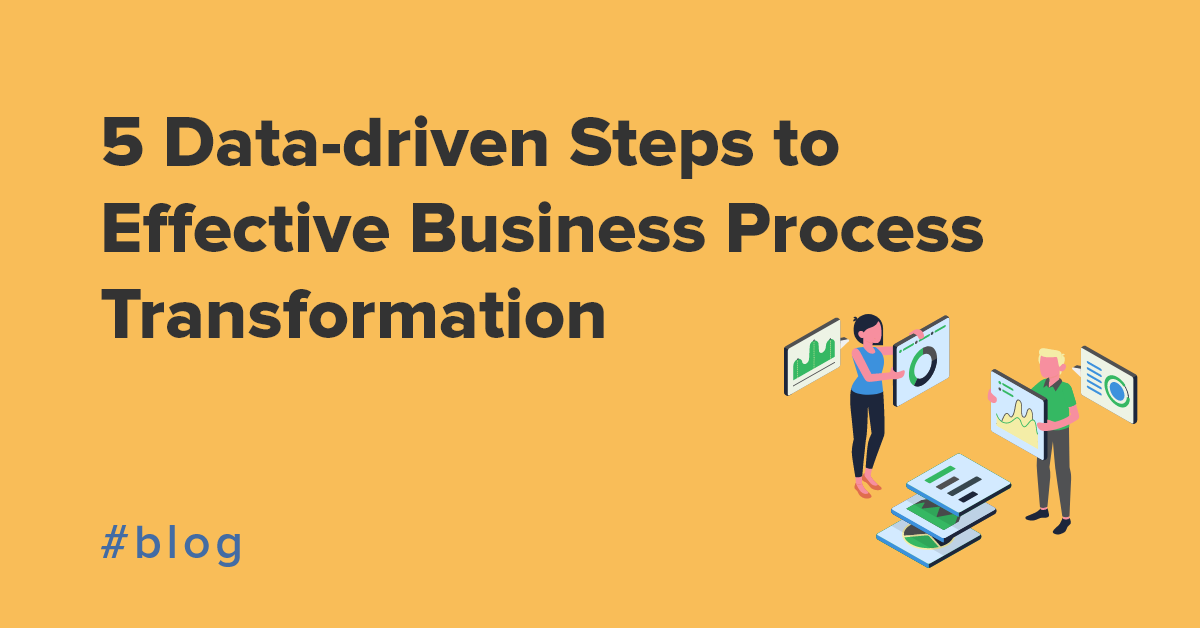‘Bring data into business process transformation efforts.
Recognize the criticality of data in process initiatives.’
- Connie Moore, business process expert at CIO
Usually, business transformation is driven by regulatory or industry needs and involves automating as many processes as possible. And, your wider business process change initiatives should always align with business objectives and not reduce complexity where possible.
BPT is fundamental to organizational success. And even small improvements can lead to big wins. For example, one business found that changing just one process saved them over $300,000 per year.
But change for the sake of change is rarely a winning strategy. Done right, transforming business processes to achieve specific goals is a key strength. Done poorly, it’s a dangerous waste of time and money.
What makes the difference between success and failure is having clear steps for transforming business processes and putting your data at the heart of everything you do. The effective integration of data into business processes simply cannot be an afterthought. This means business process transformation strategies increasingly require help from data experts and a careful, guiding hand to ensure they deliver on their promised outcomes.
Drawing on the success of our own client projects, we’ve created a five-step system you can use to fuel your own business process transformation. At each stage, we’ve outlined why data (and the value it brings) is the linchpin for reaching your organizational goals.
Before we look at the data-driven steps to achieve effective business process transformation, let's clarify what we're talking about. Here is a definition of business process transformation:
What is business process transformation? (a quick definition)
Business process transformation (BPT) is a blanket term that refers to the steps an organization takes to change their businesses processes in order to improve how they work overall or reach a certain goal. Government laws, regulations and changes in the economy can often prompt BPT.
Now, let’s explore the 5-step process.
1. Define the goal of the business process transformation
The first step to successful business process transformation is establishing goals that align with your business vision (as well as your data architecture) will definitely move the needle toward success.
Below are three suggested goals to consider:
- Improve the time to value of the business process because you can’t afford to spend months developing something.
- Reduce the cost of the process. This is especially important for processes you know you’ll need to repeat regularly – audits are an example of this.
- Simplify the process to make it error-proof because regulations (especially in the financial sector) have high penalties.
But what do tangible outcomes and success look like in practice?
One example is how CloverDX helped a client to build a data bridge that resolved headaches they were having. The problem was that the client needed to better predict the time and cost needed to perform an audit.
Unfortunately, uncorrelated data sets, duplications, and needless business processes meant the team had little visibility into the complexity of their data transformations and struggled to keep track of data lineage.
We helped them solve this problem by designing a data bridge that transformed their data models into actionable run-time processes, eliminating the loss of key data transformations to a sea of messy scripts and procedures.
These delivered outcomes that were of tangible benefit to the client, helped to improve their data governance, and are an example of how, when done right, business process transformation can solve a real problem.
White Paper: Bridging the Gap Between Data Models and Data Pipelines2. Prepare to talk to your organization and stakeholders
It takes a certain amount of power to push through organizational change. If you have enough power, you can make the changes yourself, but if you don’t, you’ll have to find someone who does and convince them to support you. Then they can use their charm and credibility to fight the case. There’s simply no other way to do it – just complaining doesn’t take you far.
It’s also important to ensure your organization is both ready for change and has a real need to improve the process you’re targeting. If you try to swim upstream, the transformation will often become protracted or even obsolete. You’ll waste time, and your business will waste money.
A core part of preparing your organization is getting stakeholders onboard. This involves:
- Matching outcomes of the transformation with their vision
- Identify and manage potential risks to limit downside
- Talk explicitly about the benefits and in a compelling manner
- Demonstrate what you’re planning to do works
- Keep things simple enough so that you can explain them
- Ensure the project has real value
- Clarify what you’re doing (ambiguous projects are the enemy)
3. Establish key data metrics and integrate effectively (work toward specific business goal)
Now that you’ve set your goals and gained the support you need, it’s time to decide which metrics you’re going to track. This will help you determine whether the transformation is a success and allow you to monitor progress along the way.
Without tracking at least a few key data metrics, you’re simply throwing darts in the dark. Sure, once in a blue moon you’ll hit the bullseye, but you’ll waste A LOT of time and energy doing it.
Choose data metrics that align with the goal of the business process transformation. For example, if you’re trying to improve the speed of a process, time is going to be a critical component. Without metrics of success you’re doomed to failure – it’s as simple as that.
Step 4: Start testing and monitor your progress
Before you roll out the process company-wide, it’s wise to run a test to see if it’s a success. When you start small, you reduce risk, use less resource, and it’s easier to get buy-in, which makes it more likely to succeed. But also ensure you don’t start small with something that doesn’t scale – deciding to do something in a sloppy way because ‘at small scale it’s okay’ is short-term thinking that will come back to bite you.
When you’re gathering data from testing, remember to focus on the goal of the transformation. At the same time, it’s important to monitor your data and ensure that the new process doesn’t create unintended problems within your enterprise data architecture.
For example, you might achieve your goal of accelerating time to value. But if the uptick in speed leads to a higher amount of unacceptable data errors, you may need to refactor or think again.
5. Roll-out the new business process
Once you’ve gathered enough data, you can check the results, and decide whether the business process yields the improvements you were hoping for. If you’re happy, it’s now time to green-light the new process, make it a new aspect of your data architecture principles and roll it out across the company.
But hold your horses – this isn’t time to sit back and relax. Since there are other variables that come into play when you take the process into production, it’s still important to monitor your data and confirm that its behaving as effectively as it did in the test scenario. For example, scale might cause an unanticipated problem that you’ll need to rectify as soon as possible.
Successful business process transformation demands effective data integration
Transforming your business processes is key to unlocking value in your business and achieving real business outcomes.
If you follow the steps we’ve covered, you’ll put your best foot forward, and give your business process transformation every chance of success. However, your business process transformation isn’t isolated from other parts of your business. And a chain is only as strong as its weakest link.
One of the biggest risks to successful business process transformation is aligning it with a sub-optimal data strategy. Simply put, it’s easy to ruin your process transformations with low quality data or failure to identify which data you need to use.
Our earlier example of how one of our banking clients transformed one of their business processes is an example of how important data processes are, and how powerful the results can be when all the links in the chain are strong.
To learn more about how the same process can accelerate time to value in your own business, check out our guide to making data models actionable.











